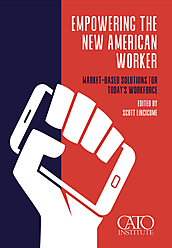Partisans today routinely insist that free markets can no longer address the needs of American workers and, in fact, often undermine them. Thus, the story goes: we need new government interventions—wage subsidies, child allowances, paid leave mandates, tariffs, industrial subsidies, contract restrictions, etc.—to rescue drowning American workers and their families.
This prevalent view, however, suffers from obvious flaws.
For starters, there never has been a Golden Age when everything was perfect for American workers and their families. Tradeoffs in work, life, and family have always existed and always will. Government cannot change this reality. No one can.
In many important ways, moreover, Americans have it much better today— even after a global pandemic and rampant inflation—than they did just a few decades ago.1 An American born in 1976, for example, has experienced significant long-term improvements, not merely in consumer goods and technology, but also in incomes, poverty, life expectancy, infant mortality, education, environmental quality, and more.2 And, while the pandemic was surely terrible for most Americans, it would have been far worse—more death, more misery, etc.—if it had occurred just 20 years earlier.3
Perhaps most importantly, and as documented throughout this book, the claim that markets have failed American workers ignores the panoply of federal, state, and local policies that distort markets and thereby raise the cost of health care, childcare, housing, and other necessities; lower workers’ total compensation; inhibit their employment, personal improvement, and mobility; and deny them the lives and careers that they actually want (as opposed to the ones DC policymakers think they should want).
Indeed, just as technology, globalization, recessions, and then the pandemic were increasingly disrupting our world and workplaces, governments—through licensing, zoning, criminal justice, benefits, education, and myriad other policies— were making it increasingly difficult for Americans to adjust and prosper, often under the guise of “pro-worker” policy.
In truth, it’s policymakers who have failed American workers over the last several decades, not some mythical “free market.”
These realities argue for a new approach to policy targeting today’s American worker—one that all but the most hardened of skeptics should embrace:
- First, reform the anti-market policies that economic experts of all stripes have shown to lower most Americans’ living standards and to inhibit employment and mobility. Doing so is particularly important for low-income and low-skill workers, who suffer reduced living standards and increased financial distress in high-cost, heavily regulated cities like New York than they do in more affordable ones like Houston.4 Yet current federal, state, and local policies not only increase less-skilled workers’ economic burdens in expensive American cities but also discourage them from moving to cheaper ones.
- Second, implement commonsense, market-based policies—regarding education, remote work, independent work, employee benefits, and others—to better reflect our modern workforce and economy and what the New American Worker actually wants. Surveys show, for example, that we increasingly value flexibility over wages and independence over employment security. Yet many in Washington think of the American worker as helpless and in need of government protection from cradle to grave, despite the long-term harms that such policies inflict on these very same workers and the economy more broadly. By contrast, pro-market policies that respect the individual agency and ability of all workers would allow them to pursue their unique hopes and dreams in a more dynamic, diverse, and high-wage economy—and to adjust to whatever comes next.
- Third, policymakers should consider new pro-worker government interventions in the economy only after the aforementioned reforms are undertaken and real but rare market failures (not those actually caused by government) are demonstrated. Any proposed policy solutions, moreover, should be crafted to minimize drags on labor productivity and economic growth. Simply throwing more money at an existing program or creating yet another new program to address the challenges facing today’s American workers promises to create higher costs and more distortions, not alleviate the concerns that are today mistakenly blamed on the free market. It also denies American workers the freedom and responsibility they deserve.
Of course, even if governments were to adopt this book’s recommendations in their entirety, a labor utopia would not magically appear. Nevertheless, the policies proposed herein offer a better way forward than the anti-market labor agendas now popular on the left and the right. Time and again, including during the pandemic, we have seen that freer markets can best deliver vital goods and services, often in new and once-unimaginable ways. We’ve seen that protected, subsidized, and over-regulated markets, by contrast, produce higher prices, fewer choices, and even shortages when problems inevitably arise. And we’ve seen that American workers can, through their own initiatives, not merely survive our disruptive and messy modern world but eventually thrive therein—if governments will let them.


